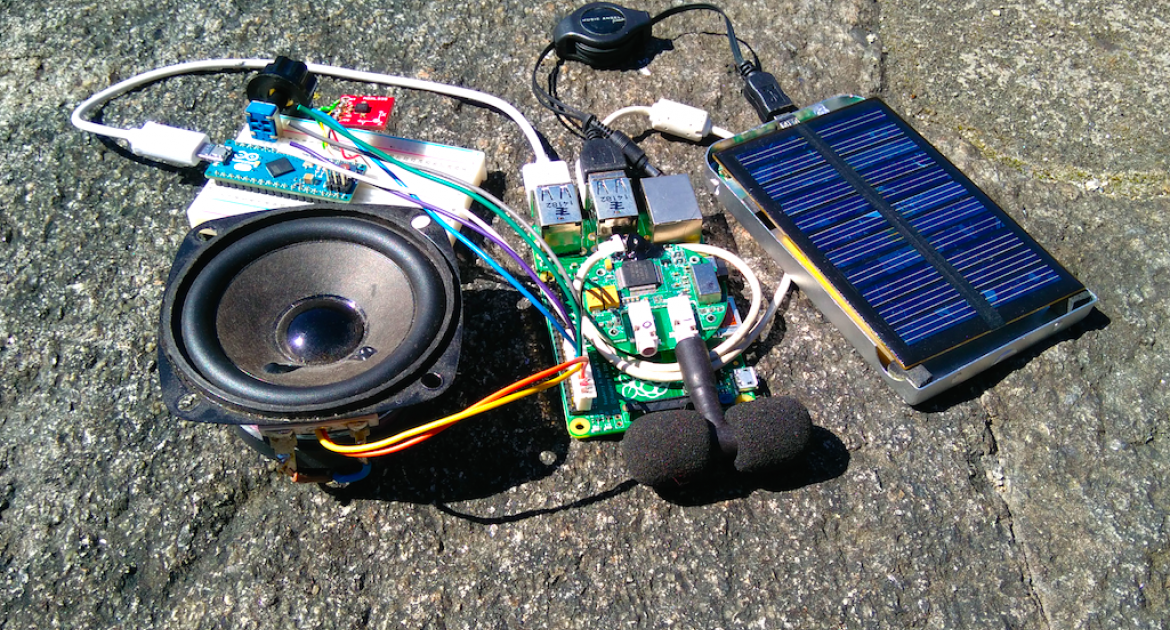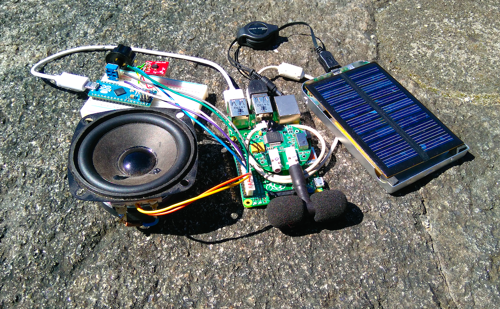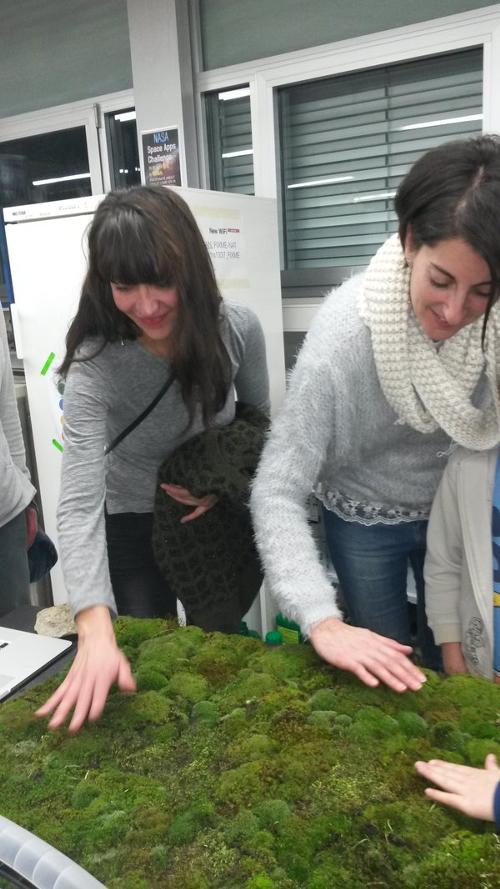Interactive Residencies?’16: Possible Worlds. Creative and Collaborative Uses of Digital Technology. Selected Projects

The residencies are part of the Interactivos?'16 programme and the projects will be taking place through open workshops with interested users, who can get involved via a public application process. The completed projects will be presented in public at the end of the residency.
The judging panel comprising Sonia Mulero on behalf of the Banco Sabadell Foundation, three members of the Medialab-Prado team (1 vote) and artist Daniel Canogar as independent member met on 26 April.
The 3 projects selected to run from 14 June to 5 July are:
- Birdbots/Soundbots by Servando Barriero.
- libre Stitch by Raúl Nieves Pardo.
- Madritmos by Max Kazemzadeh.
The 3 projects selected to run from 11 to 30 July are:
- Biofilia Urbana by Vanessa Lorenzo.
- Choreo-Graphic Coding by Joana Chicau.
- Puredata and Blender Applied to Small Format Mapping by Raimon Guarro i Nogues.
BirdbotsS by Servando Barreiro (Sanxenxo)

This installation consists of a series of robots that interact with each other by sending and receiving sounds. In one sense, it's halfway between a multi-channel audio installation, a cyberpunk sculpture and a jungle full of animals making sounds.
What would happen if we activated self-teaching robots in an environment where they're exposed to multiple stimuli (sound, light, human presence, etc.)?
The idea is to see how the language they communicate with evolves. Instead of using a digital network, they'll use their skills to synthesise and analyse sounds that are perceptible to humans. Human interaction will be part of the analysis, as sounds made by members of the public will be included, which may trigger chain reactions in the robots from time to time.
libreStitch by Raúl Nieves Pardo (Barcelona)
libreStitch is an augmented rag loom, an artefact for hybrid fabric manufacture. It's a digital, interactive loom that can manage complex patterns in a user-friendly way.
An augmented loom is not an elektroknit machine (a fully automated robot into which you feed a pattern and it takes over both the act of producing and the product), nor a traditional loom that gives no feedback to the user.
libreStitch is a prototype designed to preserve all the properties of the craft production activity (inherent to the product and the social, physical and emotional activity itself) while speeding up the ability to learn new stitches and multiplying the number of patterns created or shared in tangible fabrics.
Using a series of simple sensors and actuators (presumably photo-resistor and RGB LEDs) libreStitch will be able to read the user's work and guide how fabrics are made with different stitches. Multi-coloured patterns can be made too, by using several strands of colour to produce pictures, motifs and symbols. These complex patterns can be computer generated and easily transferred to the artefact (previously or) after they have been (self)made or distributed.
Madritmos by Max Kazemzadeh (Washington DC)

“Madritmos” (“Mad”: Madrid, “ritmos”: algorithms) is a performatic project that's interactive, digital, kinetic and uses geo-location. The project uses algorithmic functions calculated with a GPS application for Android phones, designed with the intention of guiding users and “passengers” as they move around the city of Madrid.
Influenced by French Situationists, who experimented with various norms for navigating around Paris with the intention of breaking with routine and having new experiences of the city from new perspectives, “Madritmos” will use a phone app which, when the phone is shaken, will guide “passengers” by suggesting different directions and distances as well as activities, such as eating certain foods or asking the name of the person nearest to them. They then have to shake the phone again to get the next instruction.
One major feature common to all these projects (Egyprithms, Dabariths, Beirithms and Madritmos) is that content is always local and current, coming from the algorithms and activities of the “passenger/gatherer” on the ground who is guided by the mobile phone application/algorithm. Their movements are also reflected in an installation that reacts and automatically shows the actions of the “passenger/gatherer's” activities.
Biofilia by Vanessa Lorenzo (Lausanne)

The charismatic urban mega-fauna grab all our attention whereas the micro-fauna and flora around us are invisible to our eyes. Our senses aren’t aware of these micro-interactions and micro-landscapes.
The aim of the project is to investigate invisible connections between urban environments and their biodiversity, data mining and mapping, living organisms and basic/medium electro-computing. We experiment with organic material, food, technology and scientific processes, in order to explore and question how biological material is handled in our everyday surroundings, our bodies and our kitchens.
The project emphasises the influence of new media, digital and electronic media in living organisms, creating unlikely connections between methods of growing organisms, domestic electro-computing and contemporary artistic commitments to biotechnology and the environmental crisis.
Choreo-Graphic Coding by Joana Chicau (Oporto)

What can we learn from choreography in terms of the challenge of reconstructing space, time and movement, and how can we turn ourselves into resources for action in the exploration of the potential for violating the constraints of current media standards?
Choreography can be understood as a way of opening doors in order to question the environments of the media around us and the fixed conventions of existing structures. With this project, Joana Chicau intends to carry out a series of “trials” that will attempt to tackle this issue. The result will be the collective construction of a “choreographic code” that can be read in digital interfaces and that will translate concepts and topical concerns discussed during the residency.
Like choreography, web design deals with space, time and the qualities of movement. The field of web design can perhaps be compared to a series of choreographies developed over time; like a system of cultural storage, a dynamic archive of transitions, conventions and historic aesthetic preferences, developed and put to use by designers. In this sense, choreography can be understood as a way of reflecting and seeking alternative ways of using visualisation tools and systems, as well as how information is accessed and distributed.
Puredata and Blender applied to small format mapping by Raimon Guarro i Nogues (Barcelona)
Puredata and Blender applied to small format mapping is a project that sets out to delve into the possibilities that these two free tools might offer for audio-visual mapping projects. The project approach is predominantly practical (although with some theoretical and methodological insights) in which the aim is the collective production of a final piece of mapping on a two-dimensional picture. Throughout the process, participants will be playing a leading role as facilitators of the learning experience, contributing and receiving knowledge, methodologies and attitudes.
Puredata and Blender are two computing tools that, in fact, come from different methodologies that complement each other. Puredata is one of the quintessential applications in free software for real time interactions. Blender is a 3D creation tool that's also extremely well-known in the world of free software.
The core idea behind the project is the need to find or produce viable and functional free software solutions for adapting projections in mapping shows; solutions that can handle the functions of commercial software programs like Millumin and MadMapper.




 Medialab-Matadero Madrid
Medialab-Matadero Madrid